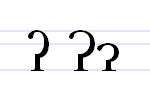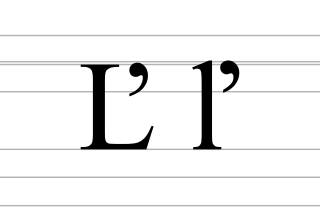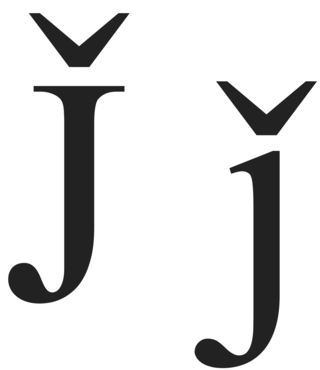A caron is a diacritic mark (◌̌) commonly placed over certain letters in the orthography of some languages to indicate a change of the related letter's pronunciation.
The African Reference Alphabet is a largely defunct continent-wide guideline for the creation of Latin alphabets for African languages. Two variants of the initial proposal were made at a 1978 UNESCO-organized conference held in Niamey, Niger. They were based on the results of several earlier conferences on the harmonization of established Latin alphabets of individual languages. The 1978 conference recommended the use of single letters for speech sounds rather than of letter sequences or of letters with diacritics. A substantial overhaul was proposed in 1982 but was rejected in a follow-up conference held in Niamey in 1984. Since then, continent-wide harmonization has been largely abandoned, because regional needs, practices and thus preferences differ greatly across Africa.

The letter F with hook is a letter of the Latin script, based on the italic form of f; or on its regular form with a descender hook added. A very similar-looking letter, ⟨ʄ⟩, is used in the IPA for a voiced palatal implosive.

A digraph or digram is a pair of characters used in the orthography of a language to write either a single phoneme, or a sequence of phonemes that does not correspond to the normal values of the two characters combined.

Ezh, also called the "tailed z", is a letter, notable for its use in the International Phonetic Alphabet (IPA) to represent the voiced postalveolar fricative consonant. For example, the pronunciation of "si" in vision and precision, or the ⟨s⟩ in treasure. See also the letter ⟨Ž⟩ as used in many Slavic languages, the Persian alphabet letter ⟨ژ⟩, the Cyrillic letter ⟨Ж⟩, and the Esperanto letter ⟨Ĵ⟩.

The grapheme Čč is used in various contexts, usually denoting the voiceless postalveolar affricate consonant like the English ch in the word chocolate. It is represented in Unicode as U+010C and U+010D.
The first Slovak orthography was proposed by Anton Bernolák (1762–1813) in his Dissertatio philologico-critica de litteris Slavorum, used in the six-volume Slovak-Czech-Latin-German-Hungarian Dictionary (1825–1927) and used primarily by Slovak Catholics.
English rarely uses diacritics, which are symbols indicating the modification of a letter's sound when spoken. Most of the affected words are in terms imported from other languages The two dots accent, the grave accent and the acute accent are the only diacritics native to Modern English, and their usage has tended to fall off except in certain publications and particular cases.

Esh is a character used in phonology to represent the voiceless postalveolar fricative.

The grapheme Ž is formed from Latin Z with the addition of caron. It is used in various contexts, usually denoting the voiced postalveolar fricative, the sound of English g in mirage, s in vision, or Portuguese and French j. In the International Phonetic Alphabet this sound is denoted with, but the lowercase ž is used in the Americanist phonetic notation, as well as in the Uralic Phonetic Alphabet. In addition, ž is used as the romanisation of Cyrillic ж in ISO 9 and scientific transliteration.

The character ⟨ʔ⟩ called glottal stop, is an alphabetic letter in some Latin alphabets, most notably in several languages of Canada where it indicates a glottal stop sound. Such usage derives from phonetic transcription, for example the International Phonetic Alphabet (IPA), that use this letter for the glottal stop sound. The letter derives graphically from use of the apostrophe ⟨ʼ⟩ or the symbol ʾ for glottal stop.
Dž is the seventh letter of the Gaj's Latin alphabet for Serbo-Croatian, after D and before Đ. It is pronounced. Dž is a digraph that corresponds to the letter Dzhe (Џ/џ) of the Serbian Cyrillic alphabet. It is also the tenth letter of the Slovak alphabet. Although several other languages also use the letter combination DŽ, they treat it as a pair of the letters D and Ž, not as a single distinct letter.

Ľ is a grapheme found officially in the Slovak alphabet and in some versions of the Ukrainian Latin alphabet. It is an L with a caron diacritical mark, more normally ˇ but simplified to look like an apostrophe with L, and is pronounced as palatal lateral approximant, similar to the "lj-" sound in Ljubljana or million.
The grapheme Ť is a letter in the Czech and Slovak alphabets used to denote /c/, the voiceless palatal plosive, the sound similar to British English t in stew. It is formed from Latin T with the addition of háček; minuscule (ť) has háček modified to apostrophe-like stroke instead of wedge. In the alphabet, Ť is placed right after regular T.

The grapheme Ň is a letter in the Czech, Slovak and Turkmen alphabets. It is formed from Latin N with the addition of a caron and follows plain N in the alphabet. Ň and ň are at Unicode codepoints U+0147 and U+0148, respectively.
Polish orthography is the system of writing the Polish language. The language is written using the Polish alphabet, which derives from the Latin alphabet, but includes some additional letters with diacritics. The orthography is mostly phonetic, or rather phonemic—the written letters correspond in a consistent manner to the sounds, or rather the phonemes, of spoken Polish. For detailed information about the system of phonemes, see Polish phonology.

Đ, known as crossed D or dyet, is a letter formed from the base character D/d overlaid with a crossbar. Crossing was used to create eth (ð), but eth has an uncial as its base whereas đ is based on the straight-backed roman d, like in Sámi Languages and Vietnamese. Crossed d is a letter in the alphabets of several languages and is used in linguistics as a voiced dental fricative.

J̌ is a letter of the Latin alphabet, derived from J with the addition of a caron (háček). It is used in some phonetic transcription schemes, e.g. ISO 9, to represent the sound. It is also used in the Latin scripts or in the romanization of various Iranian and Pamir languages, Armenian, Georgian, Berber/Tuareg, and Classical Mongolian. The letter was invented by Lepsius in his Standard Alphabet on the model of š and ž to avoid the confusion caused by the ambiguous pronunciation of the letter j in European languages.
Dz is a digraph of the Latin script, consisting of the consonants D and Z. It may represent, , or, depending on the language.
Greek orthography has used a variety of diacritics starting in the Hellenistic period. The more complex polytonic orthography, which includes five diacritics, notates Ancient Greek phonology. The simpler monotonic orthography, introduced in 1982, corresponds to Modern Greek phonology, and requires only two diacritics.










